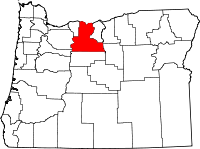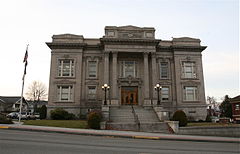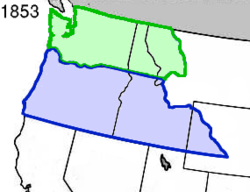- Wasco County, Oregon
-
Wasco County, Oregon Wasco County Courthouse in The Dalles 
Location in the state of Oregon
Oregon's location in the U.S.Founded 11 January 1854 Seat The Dalles Area
- Total
- Land
- Water
2,395 sq mi (6,203 km²)
2,381 sq mi (6,167 km²)
14 sq mi (36 km²), 0.60%Population
- (2010)
- Density
25,213
10/sq mi (4/km²)Website co.wasco.or.us Wasco County is a county located in the U.S. state of Oregon. The county is named for a local tribe of Native Americans, the Wasco, a Chinook tribe who lived on the south side of the Columbia River. In 2010, its population was 25,213. Its county seat is The Dalles.
Contents
Economy
The county's economy is based upon agriculture (orchards, wheat farming, livestock ranching), lumber, manufacturing, electric power, transportation, and tourism. Aluminum production was previously a major support of the local economy, but electrical price fluctuations and a slump in global aluminum prices has forced the closing of a number of local aluminum foundries.
Geography
According to the U.S. Census Bureau, the county has a total area of 2,395 square miles (6,200 km2), of which 2,381 square miles (6,170 km2) is land and 14 square miles (36 km2) (0.60%) is water. The northern boundary is the Columbia River (the state line).
Adjacent counties
- Hood River County, Oregon - west
- Clackamas County, Oregon - west
- Marion County, Oregon - southwest
- Jefferson County, Oregon - south
- Wheeler County, Oregon - southeast
- Gilliam County, Oregon - east
- Sherman County, Oregon - east
- Klickitat County, Washington - north
National protected area
History
Celilo Falls on the Columbia River served as a gathering place and major trading center for the local Native Americans, including the Wasco, Paiute, and Warm Springs tribes, for thousands of years. These rapids came to be named Les Grandes Dalles de la Columbia or "The Great Falls of the Columbia" by the French Canadian fur traders.
The Dalles served initially as a way station on the Oregon Trail as it approached the Willamette Valley. The construction of the Barlow Road over the Cascades in 1845, and the Donation Land Claim Act of 1850 encouraged families to settle in the area. Over the following years, Wasco County was a major transportation hub for both river and inland traffic.
The Oregon Territorial Legislature created Wasco County on January 11, 1854 from the parts of Clackamas, Lane, Linn and Marion counties, that were east of the Cascade Range. At the time of its creation, it was the largest county in the United States, consisting of 130,000 square miles (340,000 km2) that stretched clear to the Rocky Mountains. Its northern border was the Washington Territory line (the Columbia River). When Dakota Territory (including present-day Wyoming) was created in 1861, Idaho Territory in 1863, and Montana Territory in 1864, the parts of Wasco County east of the present Oregon boundaries were ceded to those territories. Other Oregon counties were split away, and Wasco was reduced to its current size.
Dates of Secession of Other Eastern Oregon Counties County Secession Date Baker 1862 Umatilla 1862 Grant 1864 Lake 1874 Crook 1882 Morrow 1884 Gilliam 1885 Sherman 1889 Hood River 1908 The Dalles was designated the county seat with the creation of the county, and has been its only location.
The river traffic on the Columbia River was profoundly affected in 1935 by the building of Bonneville Dam in Multnomah County and by The Dalles Dam in 1957 in Wasco County (which submerged Celilo Falls).
Wasco County attracted international attention in the 1980s, when Bhagwan Shree Rajneesh went to the United States and settled for several years at a marginal ranch called "The Big Muddy", but later known as Rajneeshpuram. Disagreements over zoning rules and building codes in the beginning continued to escalate between not only his followers and the inhabitants of Wasco County, but eventually with the rest of the state. His followers, known as Rajneeshees, settled en bloc in Antelope, Oregon and were able to elect a majority of the town councillors. Acerbic, if not hostile comments by his spokeswoman, Ma Anand Sheela, only increased tensions, and were not helped by Rajneesh's vow of silence. When the Rajneeshees subsequently recruited homeless people from across the United States to settle at Rajneeshpuram, it was widely seen as an attempt to use the ballot box to seize control of the county. But perhaps the most bizarre turn of events was when an outbreak of salmonella in salad bars at ten restaurants in The Dalles were traced to the acts of his followers. About this time, Sheela was removed from her post in Rajneesh's service.
This chapter in the county's history finally ended in 1985, when Rajneesh was arrested as he was fleeing the U.S. On October 23, 1985, a federal grand jury in Portland had secretly indicted Rajneesh, Sheela, and six other of his followers for immigration crimes. Two days later, a Wasco County grand jury returned indictments against Sheela and two others, charging them with the attempted murder of Swami Devaraj, Rajneesh's personal doctor. Rajneesh entered an Alford plea and was given a suspended sentence on condition that he leave the country.
The former Rajneesh ranch is now known as "Wildhorse Canyon". It is owned and operated by Young Life Ministries, a Christian organization providing camp services for youth.
Communities
Incorporated cities
Unincorporated communities and CDPs
- Chenoweth
- Fairbanks
- Pine Grove
- Pine Hollow
- Rice
- Rowena
- Seekseequa Junction
- Tygh Valley
- Wamic
Ghost towns
Demographics
Historical populations Census Pop. %± 1860 1,689 — 1870 2,509 48.5% 1880 11,120 343.2% 1890 9,183 −17.4% 1900 13,199 43.7% 1910 16,336 23.8% 1920 13,648 −16.5% 1930 12,646 −7.3% 1940 13,069 3.3% 1950 15,552 19.0% 1960 20,205 29.9% 1970 20,133 −0.4% 1980 21,732 7.9% 1990 21,683 −0.2% 2000 23,791 9.7% 2010 25,213 6.0% [1][2][3] As of the census[4] of 2000, there were 23,791 people, 9,401 households, and 6,505 families residing in the county. The population density was 10 people per square mile (4/km²). There were 10,651 housing units at an average density of 4 per square mile (2/km²). The racial makeup of the county was 86.58% White, 3.81% Native American, 0.80% Asian, 0.50% Pacific Islander, 0.30% Black or African American, 5.65% from other races, and 2.36% from two or more races. 9.31% of the population were Hispanic or Latino of any race. 17.8% were of German, 11.8% English, 9.8% American, 9.5% Irish and 5.0% Norwegian ancestry according to Census 2000.
There were 9,401 households out of which 30.20% had children under the age of 18 living with them, 54.80% were married couples living together, 9.90% had a female householder with no husband present, and 30.80% were non-families. 26.10% of all households were made up of individuals and 11.50% had someone living alone who was 65 years of age or older. The average household size was 2.47 and the average family size was 2.96.
In the county, the population was spread out with 25.40% under the age of 18, 7.40% from 18 to 24, 25.20% from 25 to 44, 25.40% from 45 to 64, and 16.70% who were 65 years of age or older. The median age was 40 years. For every 100 females there were 97.90 males. For every 100 females age 18 and over, there were 95.10 males.
The median income for a household in the county was $35,959, and the median income for a family was $42,412. Males had a median income of $36,051 versus $21,575 for females. The per capita income for the county was $17,195. About 10.30% of families and 12.90% of the population were below the poverty line, including 17.70% of those under age 18 and 7.30% of those age 65 or over.
See also
- National Register of Historic Places listings in Wasco County, Oregon
- 1984 Rajneeshee bioterror attack
References
- ^ http://www.census.gov/population/www/censusdata/cencounts/files/or190090.txt
- ^ http://factfinder2.census.gov
- ^ http://mapserver.lib.virginia.edu/
- ^ "American FactFinder". United States Census Bureau. http://factfinder.census.gov. Retrieved 2008-01-31.
External links
Municipalities and communities of Wasco County, Oregon Cities CDPs Chenoweth | Pine Grove | Pine Hollow | Rowena | Tygh Valley | Wamic
Unincorporated
communitiesCelilo Village | Clarno | Fairbanks | Friend | Kingsley | Rice | Shaniko Junction | Wapinitia
Indian reservation Ghost towns Rajneesh movement Leadership Locations Incidents Legal cases Byron v. Rajneesh Foundation InternationalCategories:- Oregon counties
- Wasco County, Oregon
- 1854 establishments in the United States
- Columbia River Gorge
- Rajneesh movement
Wikimedia Foundation. 2010.




